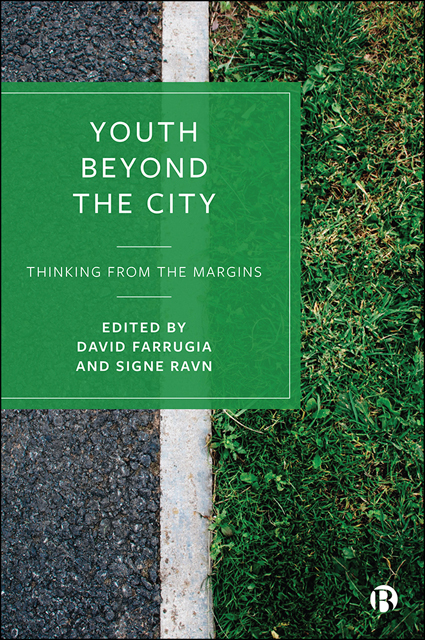Book contents
- Frontmatter
- Contents
- List of Figures and Tables
- Notes on Contributors
- Introduction: Thinking from the Margins
- Part I Inequalities: Education and Aspiration on the Margins
- Part II Materialities: Spatiality and Sensory Embodiment
- Part III Identities: Mobility, Rootedness and Belonging
- Part IV Temporalities: Historicizing Space and Place
- Index
6 - Bright Lights, No City: Investigating Young People’s Suburban and Rural Drinkscapes
Published online by Cambridge University Press: 13 October 2022
- Frontmatter
- Contents
- List of Figures and Tables
- Notes on Contributors
- Introduction: Thinking from the Margins
- Part I Inequalities: Education and Aspiration on the Margins
- Part II Materialities: Spatiality and Sensory Embodiment
- Part III Identities: Mobility, Rootedness and Belonging
- Part IV Temporalities: Historicizing Space and Place
- Index
Summary
Introduction
Geographies of young people's leisure in late capitalism have typically focused on urban centres, with suburban and rural areas often cast as places to ‘escape from’, to participate in the vibrant night-time economy of the metropolis. This chapter mobilizes sociological and geographical analyses of young people's drinking practices and experiences in suburban and rural England to explore how young people located beyond global cities creatively navigate shifting conditions of possibility and constraint shaping their opportunities to socialize. The chapter draws on qualitative research conducted by two of the authors to explore young people's drinking practices in the suburbs of Manchester, and in rural villages in Lincolnshire. We pay particular attention to how young people craft and experience ‘drinkscapes’ – that is, places in which alcohol is consumed – and to the role of classed and other socio-spatial processes of exclusion in the creation and experience of such places. Suburban and rural drinkscapes offer distinct drinking experiences; in this chapter we argue that the material cultures and sensual atmospheres of these drinkscapes have the ability to both allure and repel young people.
Drinking alcohol is a sensory, embodied practice; this is something that is receiving growing scholarly attention (for example Thurnell-Read, 2011; Wait and De Jong, 2014). Similarly, placemaking is also a phenomenon characterized by sensory engagements with material objects and environments. Pink (2008) contends that human practices of everyday life, performance and imagination are implicated in producing material and sensory realities, and a phenomenological ‘sense of place’. Drawing on two separate studies, this chapter engages with what it means to be a young person participating in drinking rituals in a context of relative spatial marginality. Indeed, the contemporary geographical imaginary of alcohol consumption tends to be one of a city centre issue (Holloway et al, 2008), typified by a large body of work on the night-time economy (for example Chatterton and Hollands, 2002; Hollands, 2002; Roberts, 2006), in which the drinkscapes of bars, pubs and clubs in city centres have received the most attention. Consequently, the specificities of suburban indoor and outdoor drinking cultures are poorly understood (Townshend, 2013), and rural youth drinking cultures have similarly received far less attention in recent research.
- Type
- Chapter
- Information
- Youth beyond the CityThinking from the Margins, pp. 116 - 134Publisher: Bristol University PressPrint publication year: 2022

